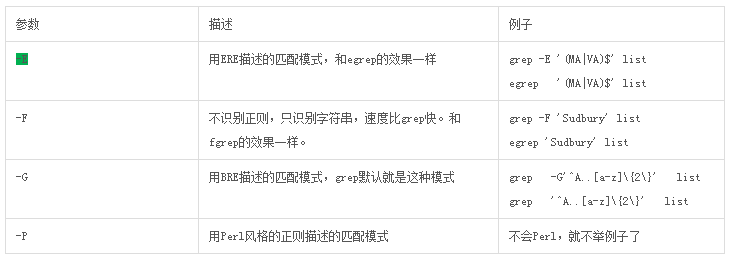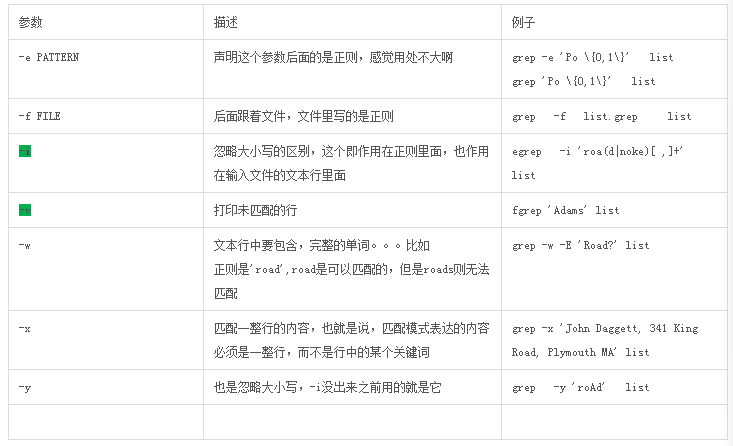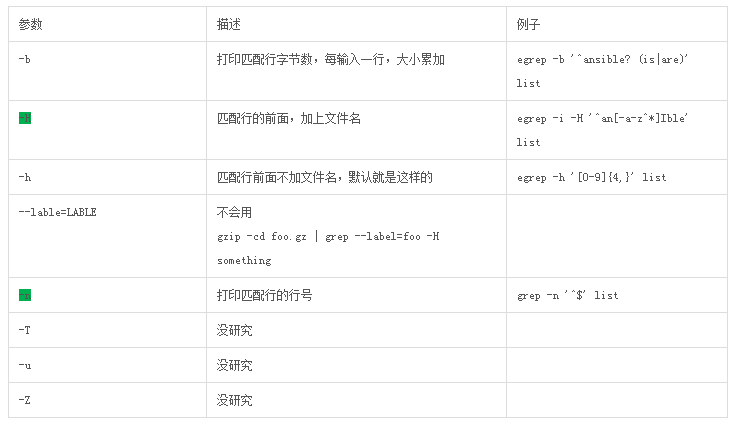Detailed explanation of grep
OK, after learning regular expressions, sed, awk, and the three text musketeers, grep is all that’s left. Let’s take it together
Let’s take a look at what grep is first
Baidu it
English: global search regular expression(RE) and print out the line
Chinese: comprehensive search regular expression(RE) and print out the line
grep is a powerful text search tool that uses regular expressions to search text and prints matching lines.
The grep family includes grep, egrep and fgrep
Principle
Tell me about the principle of grep?
After giving a file list or standard input, grep will search for text that matches one or more expressions, and only output lines or text that match
(or do not match)
In fact, to put it bluntly, The process of grep is not much different from the addressing process of sed.
Refer to the sed processing process, we summarize the grep processing process
Read a line of text into the pattern space
Search the line of text based on the specified regularity to see if there is matching content
If so, the entire line matches at once None, the line will not be processed further, delete the line and read the next line. If the match is successful, print the line and read the next line.
It seems that grep is actually a simplified version of sed. Successfully matched lines are automatically printed. However, sed needs to specify the p command to print, otherwise the entire text will be printed. Of course, grep's option provides a lot of parameters and also has many functions that sed does not have.
OK, now that this is the case, there are only two pieces of content left in grep, one is the parameters of grep, and the other is regular addressing
Speaking of regularity, the use of regularity and sed in grep, awk is a little different, sed or awk Use // to encircle the middle. In grep, there is no need for
grammar format
grep [option] pattern [file...]
grep [options] [-e pattern] -f []
grep -E is equivalent to egrep , grep -F is equivalent to fgrep, grep -r is equivalent to rgrep
Let’s take a look at grep’s [options]
In the process of introducing [options], we will give some small examples to practice metacharacters and grep, egrep , the use of fgrep.
The author uses colors for parameters that he thinks may be frequently used, and the marks are the same
grep -V This can be seen in the grep version
Test text
John Daggett, 341 King Road, Plymouth MA
Alice Ford, 22 East Broadway, Richmond VAOrville Thomas, 11345 Oak Bridge Road, Tulsa OK
Terry Kalkas, 402 Lans Road, Beaver Falls PA
Eric Adams, 20 Post Road, Sudbury MA
Hubert Sims, 328A Brook Road, Roanoke VA
Amy Wilde, 334 Bayshore Pkwy, Mountain View CA
Sal Carpenter, 73 6th Street, Boston MA
ansible is ansible
saltstcak is more powerful than (ansible),hehe
ansibl are ansible
Selection of matchers
 Matching control
Matching control
 Output control
Output control
 Output line prefix control
Output line prefix control
 Content control
Content control
 File and directory options
File and directory options
 Other options
Other options
 Exit Status
Exit Status
The matching is successful, the exit status code is 0, the matching fails, the exit status code is 1, the matching error occurs, the exit code is 2

Hot AI Tools

Undresser.AI Undress
AI-powered app for creating realistic nude photos

AI Clothes Remover
Online AI tool for removing clothes from photos.

Undress AI Tool
Undress images for free

Clothoff.io
AI clothes remover

AI Hentai Generator
Generate AI Hentai for free.

Hot Article

Hot Tools

Notepad++7.3.1
Easy-to-use and free code editor

SublimeText3 Chinese version
Chinese version, very easy to use

Zend Studio 13.0.1
Powerful PHP integrated development environment

Dreamweaver CS6
Visual web development tools

SublimeText3 Mac version
God-level code editing software (SublimeText3)

Hot Topics
 How to use grep command for log analysis in Linux?
Jul 29, 2023 pm 02:12 PM
How to use grep command for log analysis in Linux?
Jul 29, 2023 pm 02:12 PM
How to use grep command for log analysis in Linux? Introduction: Logs are important records generated during system operation. For system operation, maintenance and troubleshooting, log analysis is an essential task. In the Linux operating system, the grep command is a powerful text search tool that is very suitable for log analysis. This article will introduce how to use the grep command commonly used for log analysis and provide specific code examples. 1. Introduction to grep command grep is a file in Linux system
 How to use the grep command to query the contents of a specific first and last file
Jan 09, 2024 am 09:45 AM
How to use the grep command to query the contents of a specific first and last file
Jan 09, 2024 am 09:45 AM
If you want to view the contents of a file in a LINUX system, how can you view the first and last contents of a specified file? Let's take a look at the tutorial on using grep to query the contents of the specified first and last files. 1. Open LINUX, here we can use the UBUNTU operating system. 2. Find TERMINAL on the left taskbar and open the terminal window. 3. Add ^ after grep to specify the beginning of a certain line. 4. Add $ after the content after grep to specify the end of a certain line. 5. ^$ can be used at the same time to specify the necessary content at the beginning and end of a certain line. 6. If a character in the middle is missing or incorrect, it will not be queried. 7. Use with -i to ignore the case rules. 8. You can also use -v
 Introducing how to use the grep command to display context information under Linux
Jan 04, 2024 pm 04:41 PM
Introducing how to use the grep command to display context information under Linux
Jan 04, 2024 pm 04:41 PM
This article mainly studies the related content of grep displaying several lines of information before and after under Linux, as follows. Grep under standard unix/linux controls the context through the following parameters. grep-C5foofile displays the line matching the foo string in the file file and the upper and lower 5 lines. grep-B5foofile displays foo and the first 5 lines. grep-A5foofile displays foo and the last 5 lines to view the grep version. The method of numbering is grep-V. If you want to upgrade, the upgrade method: the latest source code (google or Baidu search homepage), compile and install it somewhere, such as /home/aaa/bin/, then use / when using it in the future. home/aaa/
 What is the syntax of Linux grep command
May 14, 2023 pm 10:43 PM
What is the syntax of Linux grep command
May 14, 2023 pm 10:43 PM
The Linuxgrep command is used to find strings that meet conditions in files. The grep command is used to find files whose content contains the specified template style. If the content of a file is found to match the specified template style, the default grep command will display the column containing the template style. If no file name is specified, or the file name is -, the grep command reads data from the standard input device. Syntax: grep parameters: -a or --text: Do not ignore binary data. -A or --after-context=: In addition to displaying the column that conforms to the template style, and display the content after the line. -b or --byte-offset: before displaying the line that matches the style
 How to use grep in Linux system?
Feb 19, 2024 pm 03:54 PM
How to use grep in Linux system?
Feb 19, 2024 pm 03:54 PM
In Linux, grep is a very common and important tool. It is a command that every professional operation and maintenance engineer must master, because it can quickly find and filter the contents of files. So how to use grep in Linux system? The following is Let’s take a look at the common usage introduction. 1. Basic usage The grep command is mainly used to search for lines of a specified pattern in files. For example, to find the line containing "example" in the file file.txt, you can use the grep command. grep 'example' file.txt grep will output all lines containing 'example'.
 What is the usage of grep in linux?
Sep 04, 2023 pm 01:55 PM
What is the usage of grep in linux?
Sep 04, 2023 pm 01:55 PM
The usage of grep in Linux is to search for lines of text that match a specific pattern and output the matching lines. The grep command has a variety of options and usages, allowing flexible search and matching operations according to different needs. Commonly used options are: 1. -i, ignore the case of characters when searching; 2. -n, display matching line numbers; 3. -c, count the number of matching lines; 4. -r, recursively search in the specified directory Search files under; 5. -l, only display file names containing matching items; 6. -v, reverse matching, output lines that do not contain matching items, etc.
 What are the uses of grep in linux?
Sep 05, 2023 am 11:01 AM
What are the uses of grep in linux?
Sep 05, 2023 am 11:01 AM
The usage of grep in Linux includes basic usage, ignoring case, regular expression search, reverse search, counting the number of matching lines, recursive search, output line number and searching from the input stream, etc. Detailed introduction: 1. Basic usage. The basic usage of the grep command is to find lines containing the specified pattern in the file. To find the lines containing "example" in the file file.txt, you can execute the command "grep "example" file.txt "; 2. Ignore case. By default, grep is case-sensitive and so on.
 What does the Linux grep command do? how to use?
Feb 19, 2024 pm 02:33 PM
What does the Linux grep command do? how to use?
Feb 19, 2024 pm 02:33 PM
When performing Linux system maintenance, if you want to quickly search for what you need in text, the grep command is a very good choice. It is mainly used to find qualified strings in files, thereby saving time and improving work efficiency. So how to use the grep command in Linux system? Let’s take a look at the detailed introduction. The Linux grep command is used to find strings that meet conditions in files. The grep command is used to search for file contents containing a specified style and display the lines containing the style. If no filename is specified, grep will read data from standard input. grep is a powerful text search tool that helps users quickly locate key information. Syntax grep[-ab






